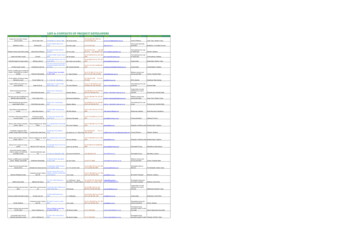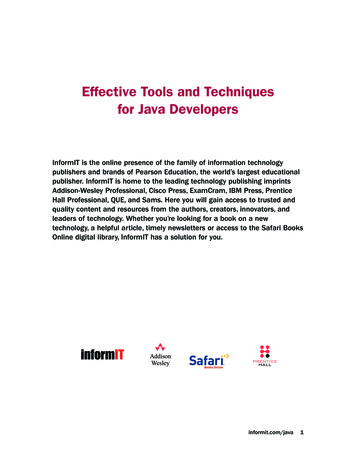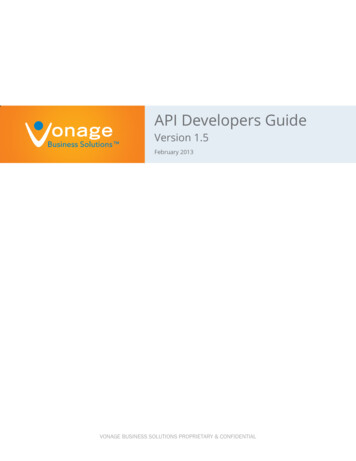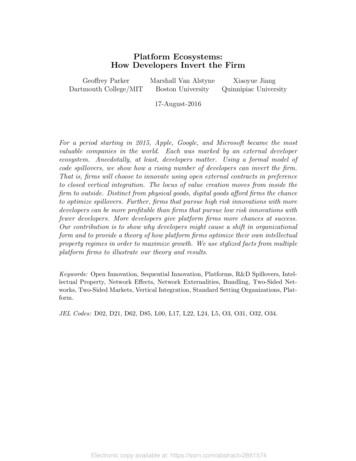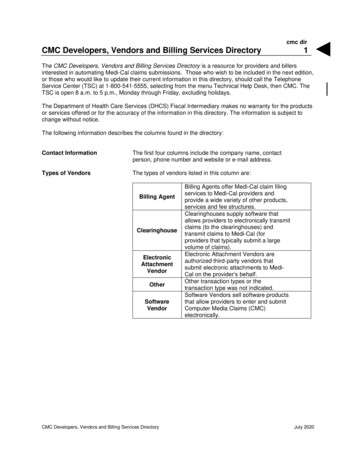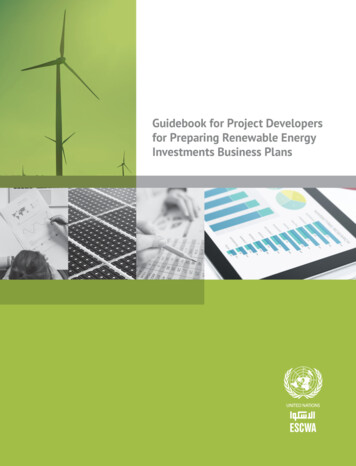
Transcription
Guidebook for Project Developersfor Preparing Renewable EnergyInvestments Business Plans
Guidebook for Project Developersfor Preparing Renewable EnergyInvestments Business PlansE/ESCWA/SDPD/2017/TECHNICAL PAPER.217-00680
2Guidebook for Project Developers for Preparing Renewable Energy Investments Business PlansAcknowledgementsThis Guidebook was prepared by the Energy Section of the Economic and Social Commission for WesternAsia (UN ESCWA) Sustainable Development Policies Division (SDPD) within the framework of the UnitedNations Development Account (DA) project on Promoting Renewable Energy Investments for Climate ChangeMitigation and Sustainable Development. The project focused on capacity-building for policymakers andproject developers in order to promote investments in renewable energy (RE) projects. The project was ledby the UN Social Commission for Western Asia (UN ESCWA) and implemented in partnership with the UnitedNations Economic Commission for Europe (UNECE).Rafik Missaoui, PhD, international expert on sustainable energy and the environment, is the publication’smain author. The following experts helped review and finalize the document: Radia Sedaou, Chief, EnergySection; Mongi Bida, First Economic Affairs Officer (SDPD/UN ESCWA); Habone Osman Moussa, AssociateProfessional, RE Finance and Project Facilitation; Simon Benmarraze, Analyst, Project Navigator, InternationalRenewable Energy Agency (IRENA); and Deltcho Vitchev, international financing expert and consultant1.Some of the material was adapted from the previous Guidebook issued by UN ESCWA on a similar topic forenergy efficiency projects2 and documents issued by UNECE during implementation of the DA project.Valuable contributions were also made by participants in the Regional Training Workshop on RenewableEnergy Project Development, Finance and Business Planning. The Workshop was held by UN ESCWA, incooperation with the Energy Investment Company in Morocco and in partnership with UNECE, in the contextof implementing the UN DA project, from 3 to 4 May 2016, in Rabat, Morocco. Information contained in thispublication was used as a support for the training sessions and discussed.1. Deltcho Vitchev also developed some of the material adapted in the Guidebook during his assignment with UNECE.2. ESCWA (July 2015): A Guidebook for Project Developers for Preparing Energy Efficiency Investments Business g/files/page attachments/guidebook ee-investments businessplans.pdf
ESCWA3Contents1.Introduction 62.General overview of renewable-energytechnologies and their development status2.1 Market status662.1.1 Worldwide renewable energy development72.1.2 Reference costs 82.1.3 Operation conditions 82.2 Main development mechanisms102.3 Main specific factors affecting RE projectsprofitability 113.Project-development process12Step 1: Identify the project idea12Step 2: Assess potential sites13Step 3: Evaluate the project13Step 4: Develop the project5.2.1 Fuel-saving5.2.2 Energy-bill reduction5.2.3 Direct job creation2222235.3 Greenhouse gas emission mitigation236Profitability calculation236.1 Basic concepts242424252526266.1.1 Capital expenditure6.1.2 Operating expenses6.1.3 Cash flows6.1.4 Inflation rate6.1.5 Discount rate6.1.6 Weighted average cost of capital6.2 Calculation of profitability indicators136.2.1 Net present value6.2.2 Internal rate of return6.2.3 Capital enrichment ratio6.2.4 Payback period6.2.5 Levelized cost of energy282829303132Step 5: Financial closing146.3 Conditions for profitability34Step 6: Implementation14Step 7: Operation 14Step 8: Decommissioning157Financing plan 357.1 Financial instruments for renewableenergy projects35Business-plan development154.1 Executive summary164.2 Profile and history of the developer164.3 Project description164.416Equity financing36Senior debt 3636LeasingMezzanine financing37(subordinated debt finance)7.1.5 Project financing377.1.6 Vendor financing38(equipment supplier/vendor credit)177.2 Disbursement and repayment plan388Requirements of financial institutions398.1 Project documentations required byfinancial institutions394.Business model4.5 Financial assessment4.6 Sensitivity analysis 174.7 Operation plan 174.8 Construction plan and timeline184.9 Risk mitigation plan 184.9.1 Investment risks4.9.2 Risk management18184.10 Marketing or consultation plan207.1.17.1.27.1.37.1.48.1.1 General documentation 398.1.2 Specific documentation for renewable energy39projects8.2 Creditworthiness appraisal404.11 Appendices/attachments 218.2.1 Analysis process 40418.2.2 Components of the credit analysis5References 42Environmental and other benefits215.1 Benefits of renewable energy projects215.2 Evaluation of benefits for thenational economy22Annex: project presentation template43
4Guidebook for Project Developers for Preparing Renewable Energy Investments Business Plans4ESCWAFiguresFigure 1: Global cumulative installed wind capacity and annual additions, 2006–20167Figure 2: Global cumulative installed photovoltaic capacity and annual additions 2006–20167Figure 3: Global cumulative installed CSP capacity, 2000–200168Figure 4: Renewable energy project development process12Figure 5: Average WACC for onshore wind for EU countries in 201427TablesTable 1: Reference information for CAPEX and OPEX for RE technologies9Table 2: Indicative operation conditions of RE technologies9Table 3: Main factors affecting the profitability of RE projects for grid-connected electricity generation11Table 4: Renewable energy project risks19Table 5: O&M costs for wind projects in OECD countries25Table 6: Inflation rates in Arab countries in 201626Table 7: Example of net present value calculation based on a provisional cash flow28Table 8: Example of internal rate of return calculation based on a provisional cash flow29Table 9: Example of capital enrichment ratio calculation based on a provisional cash flow30Table 10: Example of payback period calculations32Table 11: Example of calculation of levelized cost of energy33
ESCWA5PrefaceArab countries have an important potential of renewable energy resources, mainly solar and wind. Aware ofthis potential but also of the challenges associated with increasing energy demand, particularly electricity,most of these countries have started developing strategies and policies to promote the use of renewableenergy technologies on a large scale. They announced future high renewable energy penetration targetsin their mix and some of them have set up appropriate legal and institutional frameworks for developingprojects in partnership with the private sector.In order to meet these targets and accelerate the deployment of renewable energy, private developers andinvestors need to play an important role in the development process of relevant projects. In this regard,capacities of local developers and investors should be enhanced in order to help them to contributeeffectively in reaching their respective countries’ targets. The engagement of local developers will also helpin allowing know-how and technology transfer to Arab countries, therefore increasing the local added valueof renewable energy development.This Guidebook has been developed by UN ESWCA with this aim. Its objective is to provide guidelines forlocal renewable energy project developers and investors in order to assist them in preparing bankablebusiness plans for their projects.This document focuses mainly on renewable energy projects for power generation. Direct use of renewableenergy to provide energy services, such as heating, cooling and water-pumping, are not specifically covered.In these types of projects, renewable energy is used mainly to substitute the conventional energy sourcesand can therefore be treated in a similar way as energy efficiency from the point of view of economic andfinancial analysis. For these cases, it is recommended to refer to the guidebook developed by UN ESCWA onpreparing energy-efficiency investment business plans3.The present Guidebook was based partially on the UN ESCWA guidebook developed for energy-efficiencyproject development4, particularly the general information about financial analysis and business-planpreparation. For the theoretical concepts of financial analysis and approaches, the document is based mainlyon the European Commission (EC) Guide to Cost-Benefit Analysis of Investment Projects5 , and other classicacademic sources.3. UN ESCWA (2015): A Guidebook for Project Developers for Preparing Energy Efficiency Investments Business /files/page attachments/guidebook ee-investments businessplans.pdf4. Ibid5. EC (2014): Guide to Cost-Benefit Analysis of Investment Projects http://ec.europa.eu/regional policy/sources/docgener/studies/pdf/cba guide.pdf
6Guidebook for Project Developers for Preparing Renewable Energy Investments Business Plans1. IntroductionIn cooperation with UNECE, UN ECSWA is implementing a UN Development Account Project entitledPromoting Renewable Energy Investments for Climate Change Mitigation and Sustainable Development. Theobjective of the project is to assist the two UN Regional Commissions (RCs) to strengthen capacities of theirmember States in order to attract investments in renewable energy (RE) projects in the context of climatechange mitigation and sustainable development.The project consists mainly in providing technical assistance and training to national decision-makers,potential developers and experts in business-plan development and financing of renewable energy facilities.The development of this Guidebook on RE project investments is part of these activities. It aims at helpinglocal project developers and investors to prepare bankable business plans for RE projects, particularlyfor power generation. It introduces standard procedures and approaches for preparing such documentsand provides guidelines on project-cycle development from project identification to implementation andoperation steps.THE GUIDEBOOK IS ORGANIZED INTO SEVEN MAIN CHAPTERS, A S FOLLOWS:1. General overview of RE technologies and their development status2. RE project-development process3. Business-plan development4. Environmental and other benefits5. Profitability calculation6. Financing plan7. Requirements of financial institutionsThe Guidebook is provided with a comprehensive tool for the financial and economic analysis of RE projects.2. General overview of renewable-energy technologiesand their development status2.1 Market statusThe main technically mature RE technologies for power generation are:Wind energy, both onshore and offshore;Solar photovoltaic (PV);Concentrated Thermal Solar (CSP);Hydropower including large, medium and micro;Biomass including both biogas and biofuel;Geothermal for electricity generation.The most developed market worldwide is for wind, solar PV and CSP.
ESCWA72.1.1 Worldwide renewable energy developmentWind energy is the most developed technology with a global installed capacity of about 487 GW in 2016against 74 GW in 2006, as shown in Figure 1. The worldwide market was growing at an average annual rateof about 21% during that period.For solar PV, the worldwide installed capacity in 2016 is estimated at around 303 GWp against only 6 GWp in2006. The worldwide market was growing at an average annual rate of about 48% during that period.Figure 1: Global cumulative installed wind capacity and annual additions, 2006–2016GigawattsWorld Total487 643707415942012127413938Annual additionsPrevious year's 016Source: REN21: Renewables 2017, Global Status ReportFigure 2: Global cumulative installed photovoltaic capacity and annual additions 2006–2016Gigawatts350World Total303 6.623840173020062007200820092010201175514038Total global capacity29Annual additionsPrevious year's capacitySource: REN21: REN21: Renewables 2017, Global Status Report20122013201420152016
8Guidebook for Project Developers for Preparing Renewable Energy Investments Business PlansFigure 3: Global cumulative installed CSP capacity, 2000–200165World Total4.87 Gigawatts4321Rest of the worldSpainUnited States0Source: IRENA website: SP technology is still less developed with a total installed capacity of about 4.87 GW in 2016, mainlyinstalled in Spain and the United States.In February 2016, Morocco inaugurated the Noor solar thermal power plant in Ouarzazate. With 160 MW,the Noor I plant is the seventh largest CSP plant in the world after the first five plants in the United Statesand the Solaben plant in Spain. Its extension, planned in two additional stages (Noor II and Noor III), willincrease its power to 510 MW6, making it the largest solar plant in the world.2.1.2 Reference costsCapital cost (CAPEX) and operation cost (OPEX) influence directly the profitability of RE projects and have tobe optimized as much as possible by developers.As mentioned above, RE technology markets, particularly solar and wind, are growing fast, making pricesdecrease quickly. In addition to market-scale effect, the continual improvement of technology enhancesthese trends.In order to help local developers, we provide hereafter some reference costs for both CAPEX and OPEX.These costs are given as indicative information, because the real costs changes from country to country andfrom site to site.6. rocco-noor-ii-and-iii-csp
ESCWA9Table 1: Reference information for CAPEX and OPEX for RE technologiesRE technologyCapital cost ( CAPEX ) in USD/kWAnnual O&M ( OPEX ) in % of CAPEXHydropower - large plants1,300–2,5002.5Hydropower - small plants2,000–3,5002.5Solar PV – residential (rooftops)1,350–4,2001Solar PV - Commercial1,200–3,4001Solar PV - Utility1,050–2,4001STE
5.3 Greenhouse gas emission mitigation 23 6 Profitability calculation 23 6.1 Basic concepts 4 2 6.1.1 Capital expenditure 24 6.1.2 . 4 Guidebook for Project Developers for Preparing Renewable Energy Investments Business Plans ESCWA 4 Figures Tables Figure 1: Global cumulative installed wind capacity and annual additions, 2006–2016 7 Figure 2: Global cumulative installed photovoltaic .
